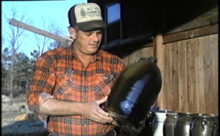Teacher's Guide, Unbroken Tradition
Teacher's Guide, Unbroken Tradition
Pre-Screening Questions
- There was a time when people didn’t run to the store to buy food. They didn’t have plastic wrap, aluminum foil and refrigerators for keeping it. What do you think they did?
- When you sit down to a meal with your family, what do you use to serve your food? How are things different from the way people served food in the past? What is on your table that people didn’t have a hundred years ago and what do you think they used instead?
- Did people use margarine a hundred years ago? What did they use instead of margarine and where did they usually get it? Have you ever made butter or known someone who has?
- Do you know what stoneware pottery is? Can you describe how it is made, from state to finish?
Discussion Questions
- What do you think makes a good piece of pottery? What do you think made a good piece of pottery in the past?
- Why do you think Jerry Brown wanted his father ‘s equipment?
- Why do you think it is so important to Jerry Brown that his sons learn to make pottery?
- Why do you think Jerry Brown and his family were willing to work so hard to make pottery? Do think they would still want to do it, even if they couldn’t earn much money by doing it? Why?
- What skills does someone in your family have that you might want to learn? What kinds of things do you remember that your parents taught you?
- When the Browns produce pottery, they gather the raw material (clay) themselves,, make the pottery and sell it. Do you know other jobs in which an individual is involved in all these stages of industry?
Class Activities
- Get a collection of stoneware or photographs of stoneware, including a churn, a pitcher, a jar, a spittoon, a jug, a face jug and see if the class can name the forms and guess how they were used. Explain how they were used_the churn to make butter, the pitcher to serve beverages, a jar to put up kraut (fermented cabbage), a spittoon for spitting tobacco into, a jug for keeping syrup, or fermented liquor, a face jug for decoration. Discuss with the class how thee forms would be used in their homes today.
- Compare the making of pottery with something that students have learned or are learning to do and arrange a class activity around this. This may involve cooking something from scratch (which has a lot in common with making pottery) or some crafts activity, which may include making pottery.
